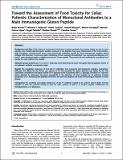Por favor, use este identificador para citar o enlazar a este item:
http://hdl.handle.net/10261/9838COMPARTIR / EXPORTAR:
 SHARE SHARE
 CORE
BASE CORE
BASE
|
|
| Visualizar otros formatos: MARC | Dublin Core | RDF | ORE | MODS | METS | DIDL | DATACITE | |

| Título: | Toward the assessment of food toxicity for celiac patients: characterization of monoclonal antibodies to a main immunogenic gluten peptide |
Autor: | Morón, Belén; Bethune, Michael T.; Comino, Isabel; Manyani, Hamid; Ferragud, Marina; López López, Manuel Carlos; Cebolla, Ángel; Khosla, Chaitan; Sousa, Carolina | Fecha de publicación: | 28-may-2008 | Editor: | Public Library of Science | Citación: | PLoS ONE 3(5): e2294 | Resumen: | [Background and Aims] Celiac disease is a permanent intolerance to gluten prolamins from wheat, barley, rye and, in some patients, oats. Partially digested gluten peptides produced in the digestive tract cause inflammation of the small intestine. High throughput, immune-based assays using monoclonal antibodies specific for these immunotoxic peptides would facilitate their detection in food and enable monitoring of their enzymatic detoxification. Two monoclonal antibodies, G12 and A1, were developed against a highly immunotoxic 33-mer peptide. The potential of each antibody for quantifying food toxicity for celiac patients was studied. [Methods] Epitope preferences of G12 and A1 antibodies were determined by ELISA with gluten-derived peptide variants of recombinant, synthetic or enzymatic origin. [Results] The recognition sequences of G12 and A1 antibodies were hexameric and heptameric epitopes, respectively. Although G12 affinity for the 33-mer was superior to A1, the sensitivity for gluten detection was higher for A1. This observation correlated to the higher number of A1 epitopes found in prolamins than G12 epitopes. Activation of T cell from gluten digested by glutenases decreased equivalently to the detection of intact peptides by A1 antibody. Peptide recognition of A1 included gliadin peptides involved in the both the adaptive and innate immunological response in celiac disease. [Conclusions] The sensitivity and epitope preferences of the A1 antibody resulted to be useful to detect gluten relevant peptides to infer the potential toxicity of food for celiac patients as well as to monitor peptide modifications by transglutaminase 2 or glutenases. |
Descripción: | 13 pages, 8 figures.-- PMID: 18509534 [PubMed].-- PMCID: PMC2386552. | Versión del editor: | http://dx.doi.org/10.1371/journal.pone.0002294 | URI: | http://hdl.handle.net/10261/9838 | DOI: | 10.1371/journal.pone.0002294 | ISSN: | 1932-6203 (Online) |
| Aparece en las colecciones: | (IPBLN) Artículos |
Ficheros en este ítem:
| Fichero | Descripción | Tamaño | Formato | |
|---|---|---|---|---|
| journal.pone.0002294.pdf | 806,74 kB | Adobe PDF |  Visualizar/Abrir |
CORE Recommender
PubMed Central
Citations
54
checked on 23-abr-2024
SCOPUSTM
Citations
141
checked on 16-abr-2024
WEB OF SCIENCETM
Citations
134
checked on 24-feb-2024
Page view(s)
369
checked on 24-abr-2024
Download(s)
256
checked on 24-abr-2024
Google ScholarTM
Check
Altmetric
Altmetric
Artículos relacionados:
NOTA: Los ítems de Digital.CSIC están protegidos por copyright, con todos los derechos reservados, a menos que se indique lo contrario.
